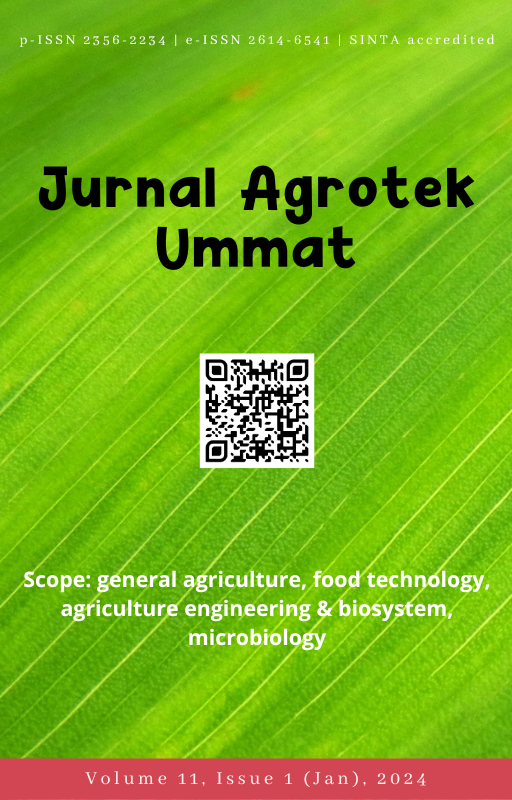Performance test of the gripper control system on a robot arm for picking tomatoes
DOI:
https://doi.org/10.31764/jau.v11i1.20868Keywords:
gripper, robotic arm, precision agriculture, tomato harvesting, variable anglesAbstract
As the demand for precision agriculture intensifies, the integration of robotics into crop harvesting processes becomes imperative. This study addresses the design and evaluation of a gripper specifically tailored for a robotic arm, aiming to enhance the efficiency of tomato harvesting. The gripper is meticulously crafted, employing a 3 mm plywood material and subjected to rigorous testing at variable angles of 40°, 45°, and 50°. The design process initiates with a meticulous blueprint and laser printing, utilizing 3 mm plywood to create a robust gripper structure. Experimental trials are conducted to assess the gripper's performance under different angle configurations. The results reveal an exemplary success rate, with a 100% achievement in the successful transfer of tomatoes without incurring any damage. The gripper's adaptability to variable angles proves crucial in maintaining. the integrity of tomatoes during the harvesting process. Furthermore, data analysis encompasses crucial parameters such as gripping time, torque exerted by the gripper, and the percentage of tomatoes successfully transferred Testing results reveal a gripping time of 0.14 seconds, indicating an efficient gripper with the highest torque at a 40° angle. The detailed design and adaptive nature of the gripper hold promise as precision technology for tomato harvesting, contributing to discussions on the integration of robotics in agriculture, particularly in optimizing harvests. Future recommendations include enhancing the gripper's structural materials for increased durability and incorporating pressure sensors to further refine its capabilitiesReferences
Abiri, R., Rizan, N., Balasundram, S. K., Shahbazi, A. B., & Abdul-Hamid, H. (2023). Application of digital technologies for ensuring agricultural productivity. Heliyon, 9(12), e22601. https://doi.org/10.1016/j.heliyon.2023.e22601
Baeten, J., Donné, K., Boedrij, S., Beckers, W., & Claesen, E. (2007). Autonomous Fruit Picking Machine: A Robotic Apple Harvester. Springer Tracts in Advanced Robotics, 42. https://doi.org/10.1007/978-3-540-75404-6_51
Chen, K., Li, T., Yan, T., Xie, F., Feng, Q., Zhu, Q., & Zhao, C. (2022). A Soft Gripper Design for Apple Harvesting with Force Feedback and Fruit Slip Detection. Agriculture, 12(11). https://doi.org/10.3390/agriculture12111802
DeSA, U. N. (2015). World population prospects: The 2015 revision, key findings and advance tables. Working PaperNo.
Guang, W., Baraldo, M., & Furlanut, M. (1995). Calculating percentage prediction error: A user’s note. Pharmacological Research, 32(4), 241–248. https://doi.org/https://doi.org/10.1016/S1043-6618(05)80029-5
He, Z., Karkee, M., & Zhang, Q. (2022). Detecting and Localizing Strawberry Centers for Robotic Harvesting in Field Environment. IFAC-PapersOnLine, 55(32), 30–35. https://doi.org/10.1016/j.ifacol.2022.11.110
Javaid, M., Haleem, A., Singh, R. P., & Suman, R. (2022). Enhancing smart farming through the applications of Agriculture 4.0 technologies. International Journal of Intelligent Networks, 3, 150–164. https://doi.org/10.1016/j.ijin.2022.09.004
Lokasari, K. N. (2011). Pengkajian kemasan dalam dan pengisi terhadap mutu buah tomat (Lycopersicon esculentum Mill.) pada kemasan peti kayu selama transportasi.
Navas, E., Fernández, R., Sepúlveda, D., Armada, M., & Gonzalez-De-santos, P. (2021). Soft grippers for automatic crop harvesting: A review. In Sensors (Vol. 21, Issue 8). MDPI AG. https://doi.org/10.3390/s21082689
Paraforos, D. S., Reutemann, M., Sharipov, G., Werner, R., & Griepentrog, H. W. (2017). Total station data assessment using an industrial robotic arm for dynamic 3D in-field positioning with sub-centimetre accuracy. Computers and Electronics in Agriculture, 136, 166–175. https://doi.org/10.1016/j.compag.2017.03.009
Rachmawati, R. (2021). SMART FARMING 4.0 UNTUK MEWUJUDKAN PERTANIAN INDONESIA MAJU, MANDIRI, DAN MODERN. Forum Penelitian Agro Ekonomi, 38, 137. https://doi.org/10.21082/fae.v38n2.2020.137-154
Rizka, G., Nrp, A., Pembimbing, D., Budiman, F., & Kontrol, K. (2017). RANCANG BANGUN LENGAN ROBOT PENJEPIT PCB 3 DOF BERBASIS ARDUINO UNTUK PROSES ETCHING PCB OTOMATIS.
Ruiz-Ruiz, F. J., Ventura, J., Urdiales, C., & Gómez-de-Gabriel, J. M. (2022). Compliant gripper with force estimation for physical human–robot interaction. Mechanism and Machine Theory, 178. https://doi.org/10.1016/j.mechmachtheory.2022.105062
Suwati, Muanah, Ahmad Akromul Huda, & Adi Gunawan. (2022). Analisis ekonomi budidaya tomat di lahan kering dengan teknik irigasi tetes. Jurnal Agrotek UMMAT, 9(3).
Vu, Q., Kuzov, M., & Ronzhin, A. (2018). Hierarchical classification of robotic grippers applied for agricultural object manipulations. MATEC Web of Conferences, 161, 03015.
Wang, G., Yu, Y., & Feng, Q. (2016). Design of End-effector for Tomato Robotic Harvesting. IFAC-PapersOnLine, 49(16), 190–193. https://doi.org/10.1016/j.ifacol.2016.10.035
Zhao, Y., Gong, L., Liu, C., & Huang, Y. (2016). Dual-arm Robot Design and Testing for Harvesting Tomato in Greenhouse. IFAC-PapersOnLine, 49(16), 161–165. https://doi.org/10.1016/j.ifacol.2016.10.030
Downloads
Published
Issue
Section
License
Authors who publish articles in Jurnal Agrotek Ummatagree to the following terms:- Authors retain copyright of the article and grant the journal right of first publication with the work simultaneously licensed under a CC-BY-SA or The Creative Commons Attribution–ShareAlike License.
- Authors are able to enter into separate, additional contractual arrangements for the non-exclusive distribution of the journal's published version of the work (e.g., post it to an institutional repository or publish it in a book), with an acknowledgment of its initial publication in this journal.
- Authors are permitted and encouraged to post their work online (e.g., in institutional repositories or on their website) prior to and during the submission process, as it can lead to productive exchanges, as well as earlier and greater citation of published work (See The Effect of Open Access).

